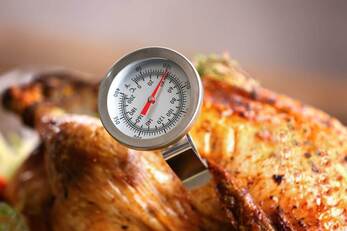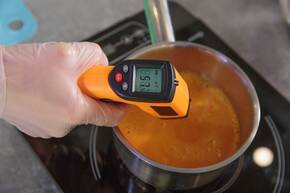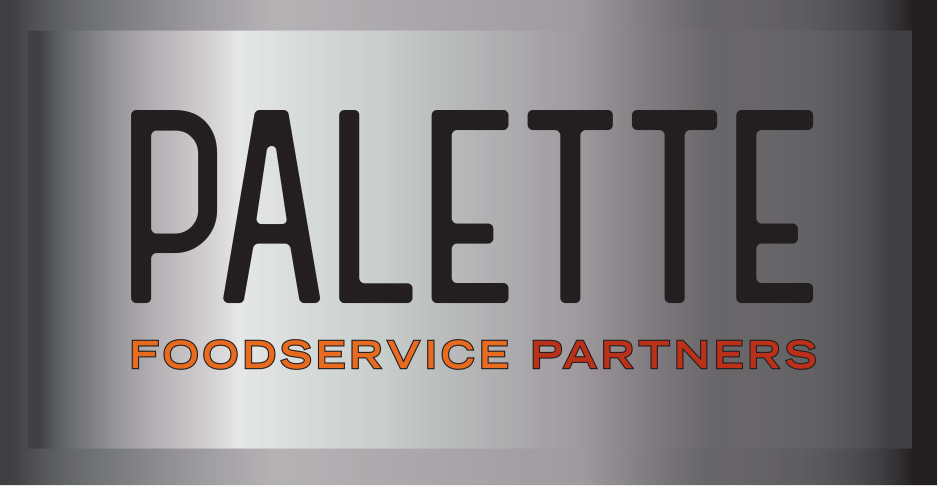 Despite the rise in real-time, tech-based controls designed to help businesses monitor foodborne illness risks, outbreaks continue to be an issue for foodservice operations. The CDC recorded 519 norovirus outbreaks between August 2023 and January of this year, a sharp rise from the previous year’s numbers, and Salmonella has impacted people across 32 states in recent months. On top of food safety technology that helps foodservice operations monitor protocols and stay alert to problems, old-fashioned food safety practices are just as important. A Food Safety Tech report says this should include thorough, frequent handwashing; proper hand hygiene prior to handling food; and the use of alcohol-based sanitizer as an added precaution – not a substitute – for handwashing. It’s also important to clean and sanitize high-touch surfaces and equipment regularly – and wash and sanitize produce to eliminate contaminants (the recent Salmonella outbreak was linked to cantaloupe and pre-cut fruit products). The report also advises careful handling and proper cooking of seafood, particularly shellfish, and having an employee policy with clear guidelines for managing staff illness, especially regarding when it’s important to avoid handling food or reporting to work.  If your business is struggling with hiring and retaining staff, it may also be struggling to carry out food safety training – or to review any processes that don’t directly support your compliance with local and state regulations. But unfortunately, a restaurant may suffer for this in the long term if employees are injured on the job or if the business faces a steep insurance claim that could have been prevented by having a strong safety culture. Your restaurant’s commitment to safety should be so woven through its fabric that senior leaders talk about it regularly and every new hire is aware of your approach before they even start their job. To make it easier to share safety knowledge and encourage retention, automate what you can – through the use of video training, gamification and digital tools that guide staff through preparation tasks that protect safety. Then take steps to broaden the knowledge of your team through regular cross-training to help fill gaps. Give your more senior staff mentoring roles with newer staff. Above all, explain the why behind why you perform certain safety practices so that tasks are less likely to fall through the cracks as you manage the other demands of your business.  When the U.S. Centers for Disease Control (CDC) led a study investigating the various factors that contribute to the cross-contamination of food in restaurants, they found more frequent cases of contamination in businesses that were lacking food safety training and certification, as well as those without handwashing policies. Contamination risks were present in restaurants that didn’t require manager certification or train workers in food safety, for example. As for handwashing, the risk for contamination was greatest in restaurants that didn’t have policies detailing where, when and how often to wash hands, or on the need to minimize bare-hand contact with ready-to-eat foods. Unfortunately, 60 percent of the foodborne illness outbreaks reported to the CDC each year connect back to restaurants, so it’s worth zeroing in on these areas if improving food safety is on your list of priorities this year. Having a staff discussion about handwashing is something a restaurant manager can do right away to help lower a restaurant’s risks – particularly at a time when seasonal viruses are common.  Want to decrease your risk of food poisoning for your guests? One important step you can take is offering paid sick leave. In a recent study by the Centers for Disease Control and Prevention, the agency tracked 800 illness outbreaks linked to 875 foodservice establishments over a two-year period and found that 40 percent of outbreaks with at least one reported factor were associated with food contaminated by an ill or infectious worker – or, in other words, a worker who should have been out sick but was working. Offering paid sick leave can be a difficult possibility to consider at a time when foodservice operations are short-staffed as it is, but it’s preferable when you consider the broader picture: You’re spreading infection to guests and other employees, and potentially causing financial and reputational damage to the brand. In one telling example from a few years ago, a national restaurant brand reported losing $1 billion in value over a five-day period after just one employee came to work with norovirus and the store employing the person did not follow its protocols about staff illness. Yet even when the risk-benefit analysis demonstrates the damage that can result when an employee comes to work sick, many studies have shown that the majority of sick employees of foodservice businesses still report to work – often because they can’t afford to lose pay or feel pressured by their employer to do so. Offering some paid time off for sick leave can serve as a safety net for both your staff and your business.  Making food safety lessons stick When you think back on the best teachers you had when you were in school, they most likely weren’t the ones who talked at you during class, expecting you to soak up everything they said or assigned homework. Yet this is how food safety training goes in many organizations. Making these lessons take hold in the minds of employees calls for a different approach. In a recent podcast discussion, Adam Spach (founder of KAS Concepts, the home of No Boring Training) and food safety experts Matthew Regusci and Francine Shaw covered what tends to make food safety training sessions more effective in getting through to participants. Of course, it’s important to teach people the right steps to take to protect safety – but just as important are the why and the how behind the actions. For example, why is it important to take the temperature of a food? Well, a person could end up in the hospital if they eat food that hasn’t been thoroughly cooked. The restaurant could even go out of business. To illustrate this, you can share some real-life examples of when this has happened for restaurants. Attaching specific stories to lessons can help them sink in – there are plenty of them available on sites such as stopfoodborneillness.org. Shaw also suggested adjusting how content is shared, encouraging the use of mnemonic devices to help people make associations to food safety knowledge. For example, you might help people remember that poultry needs to be cooked to the highest temperature as compared to other animal proteins by saying that “birds fly high.” Above all, it’s important to make food safety training feel less like a lesson and more like a conversation. It helps to encourage food safety discussion not only in classroom settings, but also in team huddles and one-on-one meetings. This can also encourage people to share their own examples of things they have seen on the job that may serve as learning opportunities for others.  In a recent webinar from Food Safety Magazine, Hal King of Active Food Safety explained how pervasive food allergies are among consumers and also identified some allergy-related vulnerabilities foodservice businesses may have. Specifically, he said food allergies affect about 15 million people and cause 30,000 visits to the emergency room. What’s more, a study conducted over a 13-year period found that half of the deaths that link back to food allergies were caused by a restaurant or other foodservice establishment. Here’s where foodservice businesses can help minimize those figures: The two primary controls that restaurants can use to avoid triggering a food allergy are avoidance messaging for the guest (on menus and other signage where food options are displayed and ordered) and prevention (by being attuned to allergens potentially being introduced by suppliers or during food preparation). King noted that one area where many restaurants fall short is on digital menus, which he said rarely include avoidance messaging to alert people to allergens and/or to the likelihood that the kitchen won’t be able to guarantee the absence of an allergen. How well do your digital menus – on your website, app, social media and elsewhere – promote allergen awareness across your brand?  If your restaurant’s food safety culture is strong, you will likely see benefits in other areas – like an improved P&L, lower employee turnover, and enhanced guest experience and loyalty. But sometimes it’s difficult to maintain a commitment to food safety across a fast-paced organization where new people are regularly coming on board. Having a few elements in place can help you cement your food safety culture across your business: First, leaders can set the right tone by clarifying expectations and weaving the benefits of food safety into regular conversations with employees and vendors across functions. Second, training can demonstrate the “why” behind required tasks, whether it has to do with the wearing of gloves or the use of a certain cutting board for a food prep task. When people know what can happen if they don’t follow a procedure, they are more apt to see its importance. Finally, bring some humility and positivity to the training process: It can be nerve-wracking to have someone watch you perform a task and then correct your mistakes, but it can help when the trainer admits when they don’t know things or aren’t sure, points out the areas where the person is performing well, and treats the identification of mistakes as progress. After all, you’re simply working together to help your organization be the best it can be.  Nothing can spoil a guest’s appetite like being served by an employee who is clearly under the weather. On the flip side, providing an environment that feels safe to guests makes a positive statement about your hospitality. Now that we’re in the season where viruses are common – and guests are especially eager to stay healthy for festive occasions around the holidays – review your health protocols with staff. Monitor employees for signs of illness, reiterate your policy about when it’s necessary to stay home, and consider encouraging employees to stay up-to-date with flu and COVID vaccines. Since a clearer policy about staff health may result in more absences, identify potential back-up supports that may help you keep up with traffic – from retooling staff scheduling, to using more speed-scratch ingredients that make preparation easier.  ‘Tis the season for heavier meals – and for many people, holiday celebrations involve having a ham, roast, turkey or other animal protein at the center of the table. If you’re offering proteins that you don’t normally feature on the menu, it’s a good time to talk with your kitchen team to review how to store these items safely during refrigeration, how to handle them safely during preparation, and steps to take to avoid cross-contamination of ingredients. You might also review the internal temperatures that various proteins need to reach for safe consumption, as well as how long various proteins can be left out before entering the temperature danger zone.  Food safety can sometimes feel like a thankless task – guests are more likely to speak up about a poor food safety experience than a great one. But that isn’t always the case. (And sharing some strong examples of food safety may help others in the business.) Earlier this year, the food safety consultancy Steritech recognized Chipotle with the 2023 Excellence in Food Safety Award – with MOD Pizza and Five Guys earning honorable mentions. Specifically, Chipotle stood out for its multi-tiered approach to food safety. That includes a focus on each link of the supply chain, from how their food is raised through every employee level to ensure safe handling and preparation. Internally, the restaurant has a Food Safety Advisory Council, a dedicated food safety section on its website and the brand invests in local and small business suppliers to help meet its food safety standards. |
subscribe to our newsletterArchives
April 2024
Categories
All
|



 RSS Feed
RSS Feed